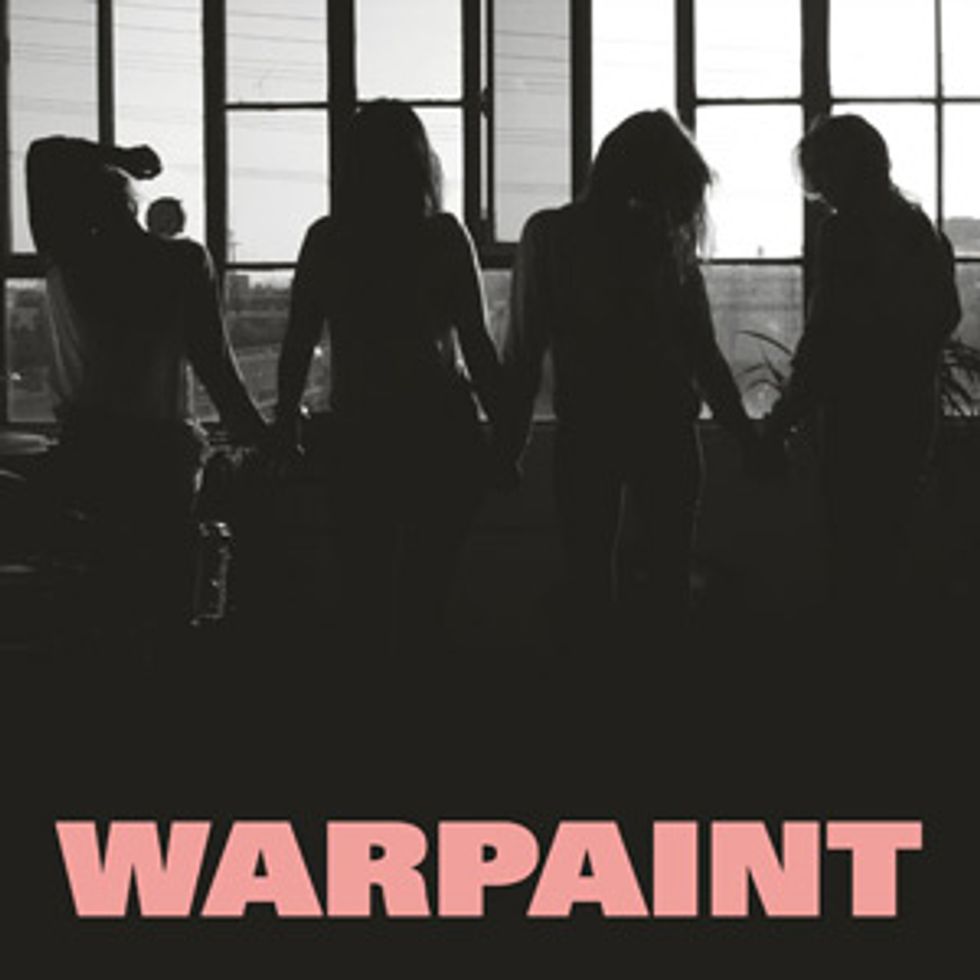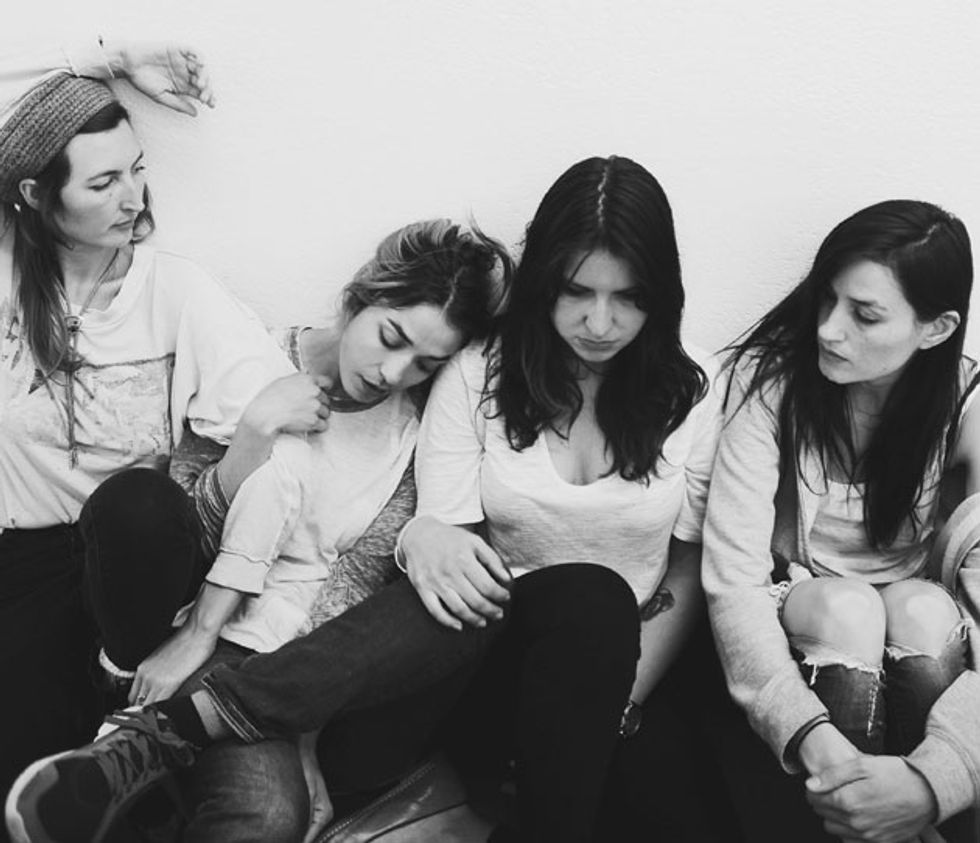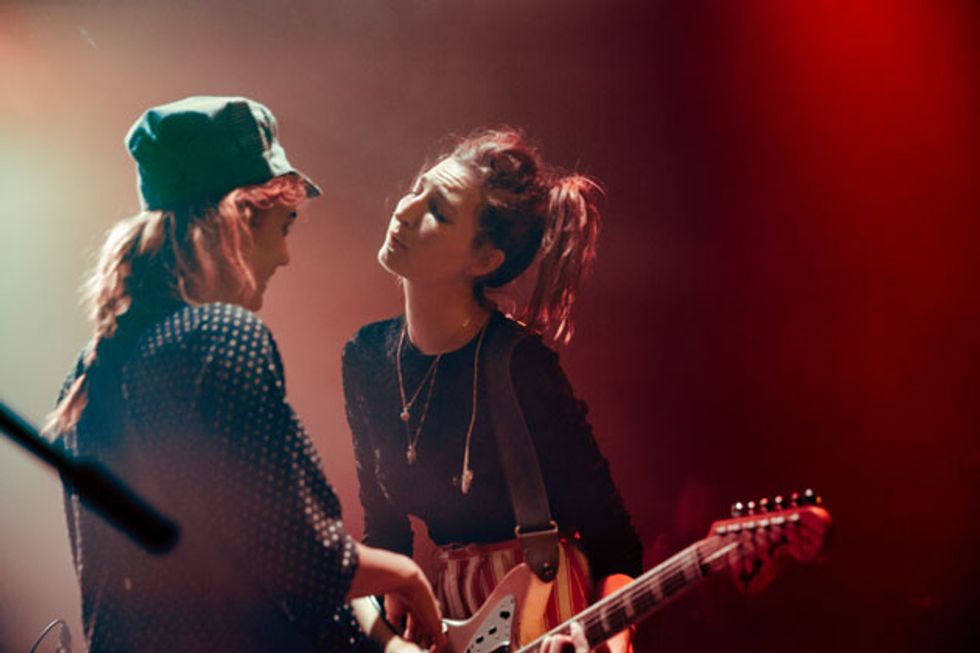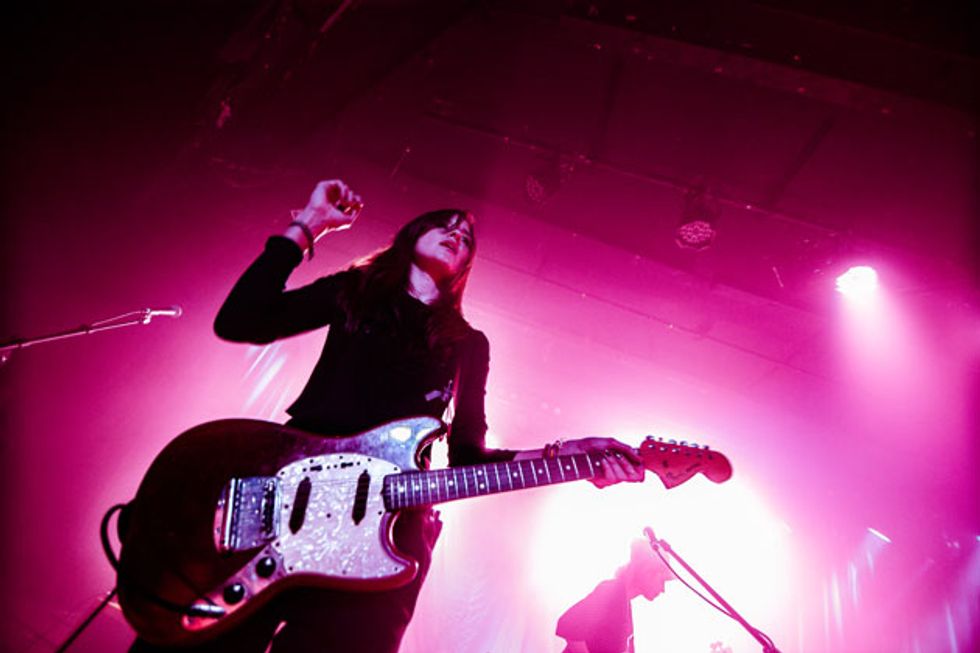“My mom was always listening to her old records,” Warpaint’s Emily Kokal says about the music she heard growing up. “She was really into Bonnie Raitt, Joni Mitchell, Neil Young, Crosby, Stills, Nash & Young, Leon Russell, and all those people—Jackson Browne—so I was around a lot of acoustic guitar music.” Guitar-based classic rock and early new wave were in the air when Kokal and Warpaint co-guitarist, Theresa Wayman, were coming of age as budding musicians in Eugene, Oregon. “Bob Dylan, Talking Heads, Al Green, Cyndi Lauper—those were all things I was listening to when I was growing up,” Wayman adds. “My friends recently made a playlist from The Harder They Come soundtrack, and I thought, ‘I listened to that album so much when I was younger.’” But it was electronic music, and specifically ’90s-era trip hop—a genre reliant on samples and drum machines—that inspired them to become musicians.
Trip hop’s dark moods, textures, noir vibe, and heavy rhythmic element—and its repetitive figures and almost trance-like quality—were what they found so alluring. “I started going back in time with music and discovering all these guitar players that had that kind of dark, moody, melody stuff,” Kokal says. “Their parts are like melodic leads.” That describes Warpaint’s music, too: linear ostinatos, unorthodox chord voicings, gentle warbles, and pulsating modulations. In many ways, their music is a re-imagining of their sample-heavy, studio-bound influences, but as a live, guitar-centric band.
“I was about 13 when I started guitar,” Wayman says. “But I wasn’t really into it for a while. I went to drumming, synths, electronic sounds, samplers, and things like that. When I was about 19, my friend had an SG and a bunch of cool pedals in his garage. I started playing with it and I realized what could happen with guitar.”
Warpaint formed in 2004 and released their first EP (mixed by John Frusciante), Exquisite Corpse, in 2008, before settling into their current lineup—Kokal and Wayman on guitars and vocals, Jenny Lee Lindberg on bass and vocals, and Stella Mozgawa on drums and vocals—in time for their first full-length album, The Fool, in 2010. Their third album, Heads Up, was released in September 2016, and although still very much a Warpaint album, marks a significant departure in how the band created their material. “A lot of the album was written in the studio,” Kokal says, distinguishing the sessions from the endless hours of jamming that preceded their previous efforts. “It was really fun, actually, and it was really different.”
Kokal and Wayman are particular about their gear. They both play vintage Fenders and rely on a floor full of pedals, including choruses, delays, and various oscillators. But where Kokal keeps it simple and only recently added overdrive, Wayman has multiple gain stages, frequency modulators, and loopers. She also uses multiple reverbs that she pairs with the one in her amp. “I adjust it every night for the room,” she says. “Some rooms you can turn your reverb way down and it’s fine. Some rooms you can’t get enough.”
We spoke with Kokal and Wayman about their non-guitar influences, unusual chord voicings, and their basic tonal-building blocks—and, although Kokal didn’t say, Wayman revealed her interest in joining a Steely Dan cover band.
Who inspired you to make music?
Theresa Wayman: The music that made me want to start making music was not guitar music—it was Björk, OutKast, and things like that. I remember sitting in my bedroom and thinking, “I want to do this. I want to make beats and something that falls into a pattern like this.” It was really repetitive and satisfying. It was down to the most basic elements and all the best little morsels were tied together to create something so satisfying. I like to incorporate guitar into that kind of music nowadays, but that’s what inspired me to make music. I fell into playing guitar, and in my band playing guitar is what worked.
Emily Kokal: When I was in high school, I was listening to a lot of rap, R&B, and a lot of stuff that wasn’t really reflected in my guitar playing, but it was definitely reflected in the mood. But what really changed my life was trip hop. Portishead, Björk, Tricky, Massive Attack—when I first heard all that music, even Radiohead, it graduated me into finding that kind of music I identified with the way my mom identified with the albums [she grew up with]. That became my music. It had a melancholy to it, but it was dark and rhythmic, and I think that also came into my guitar playing. I started playing more repetitive parts and not traditional song structures. I started getting into mantra-ing-out on a riff and darker, more melancholic sounds.
Dark textures and repetitive patterns are such a big part of your music.
Kokal: Totally. Theresa and I grew up together, we started playing guitars around the same time, and we would play songs together, but we were also discovering all this music at the same time. She bought a DJ Shadow album called Preemptive Strike and it had a song on it called “What Does Your Soul Look Like (Part 2).” There is a guitar riff in that song—the entire song is one guitar riff—and I swear that guitar riff and that song influenced me so much. I still feel like my guitar sound sounds like that one song [laughs]. It’s a sample and I just found out that it’s actually a Foreigner sample [“Girl on the Moon”] slowed down. It’s really slowed down and super sexy. I started going back in time with music and discovering all these guitar players that played dark, moody, melodic stuff. Their guitar parts are like melodic leads. I love that stuff.
Wayman: I would say it’s what gets us off. It’s like you make music that appeals to you or to your sensibilities. That’s what it is for me. I like finding the perfect hook or accent to another hook, piecing it all together, interweaving it, and creating a whole that stays within a pattern, but also morphs and changes with what you take out and put in.

FACTOID: Bassist Jenny Lee Lindberg’s older sister, actress Shannyn Sossamon (A Knight’s Tale), was Warpaint’s original drummer from 2004 to 2008. Current drummer Stella Mozgawa joined in 2009 and played drums on all three of the band’s studio albums.
You both use interesting chord voicings and stay away from bar chords, power chords, and even open chords. Where does that come from?
Kokal: When I got my first guitar when I was little, the chords sounded like shit. I would fingerpick and I got really into that. I wasn’t good at playing power chords because my fingers were so small and I wasn’t strengthening them by barring. I didn’t bar for a really long time. John—I used to date John Frusciante—he used to tell me how I played, because I didn’t know. He is more theory-based and he said, “You are really into double stops.” I would usually play two notes at a time to make harmonies. I had an open string and I’d play an open string with another note. Then I’d play a note on that open string, close it, and play another harmony. I would create shapes. The last song on our new album, “Today Dear,” is an acoustic song. It’s a song I wrote when I was 19, actually, but we put it on the record. If you listen to it, it is all double stops and harmonies.
Wayman: When I was younger, I detested the idea of playing anything like anyone else around me. I didn’t want to write songs that used A minor, G, D minor, E—the chords that many songs are written with. There is no problem with that, but I wanted to find something else. I wasn’t drawn to that and I never wrote songs with those chords. Also, when I was jamming with people, which is basically how I learned how to play, I would have this method of playing along and finding the notes that work along the neck and then putting them together into different chords. I was finding clumps of notes that work and I was probably stumbling upon voicings that were unique, different, or not used often. I never learned it from the outside in, as in, “We’re going to play in D minor now. These are the chords that work. Here are the basic formations of those chords. You can play it as a power chord here or you can play…” I didn’t learn it that way. I knew theory. I could tell you what chords are in a D minor scale if I thought about it, but I didn’t know it translated to the guitar like that. The piano is a little bit easier because it’s all right in front of you, but with guitar I never tried to learn it that way.
Emily Kokal (right) shares a happy vibe with Warpaint bassist Jenny Lee Lindberg at the Roxy in West Hollywood
during a gig on February 8, 2015. Photo by Debi Del Grande
Do you still do that? Is that how you come up with your parts in the band now?
Wayman: Yeah, though I’m starting to learn more. I’m trying to put myself through a bit of schooling—learning songs and collecting knowledge like, “This song is in this key. This is the progression they’re using and it’s these chords.” I am starting to familiarize myself in that way, where I intellectually know what’s going on. I don’t necessarily think it is important for knowing how to write a good song, but I am curious and I want to know. I want to be able to speak that language better. It’s fascinating to me. But I don’t want to be limited by my knowledge either. At this point, I’ve been doing what I’ve been doing for a long time—so it can only make me better. There are a lot of people who learn that way originally and it kind of limits them, thinking, “I have to do this. I have to do that.” It trains the ear to be within a box and a standard. I think it’s important to not know the standards. Even if I see a band I think is incredible, if I hear them writing songs that sound derivative of something it puts me off immediately. I don’t understand that. I can’t understand going, “I love this type of music. I want to play that type of music. What is that person that I love that invented that type of music doing? I’m going to do that and make a song like that.” That doesn’t make sense to me. That’s not inventive enough.
—Emily Kokal
You don’t want to learn a particular style or how to play within that style?
Wayman: Not really. Of course, taking bits and pieces is important. It’s a fine line. I don’t want to say that it doesn’t have any value, but I think it’s easy to take it too far, where all of a sudden you sound like something that’s already happened. To me, that’s slightly missing the point. But that being said, I would love to be in a cover band and play exactly like my heroes [laughs]. But that’s because I want to play their music, not because I want to write my own music that is exactly like that type of music.
What kind of cover band do you want to be in?
Wayman: My latest one is Steely Dan. I want to be in a Steely Dan cover band. Stella wants to as well—it’s her dream—so it might happen [laughs].
You flirt a lot with dissonance. You use a lot of minor seconds in your vocal lines, too. Would trip hop be the influence for that as well?
Kokal: Probably. I think trip hop was the reason I identified with it. Some people find that music to be dark, but I found it to be beautiful, especially when I was a teenager. I was going from being a teenager who liked dorky music or whatever was on the radio to finding the music that seemed dangerous, moody, kind of sexy—but mostly just English. Discovering English music. Rainy. Dark music and violence. I think that was it. I don’t think I was always attracted to that necessarily, but once I found it—I love Erik Satie, the classical composer, too—I guess it is sad music. But that kind of music makes me feel good. I sound so emo [laughs]. I like uplifting, too, but I find a lot of that stuff uplifting.
Emily Kokal’s Gear
Guitars1962 Fender Strat
1966 Fender Jaguar modified with a Mastery Bridge
A second 1966 Fender Jaguar she shares with Wayman
Blonde pre-war Martin acoustic D-28
Fender Villager 12-string acoustic
Gibson Les Paul Goldtop reissue
Amps
Roland JC-120
Effects
Electro-Harmonix Polychorus
Boss VB-2 Vibrato
Electro-Harmonix Small Clone chorus
Ibanez Tube Screamer
Strymon El Capistan dTape Echo
HardWire DL-8 Delay/Looper
Boss RV-5 Digital Reverb
Boss tuner
Strings and Picks
D’Addario (.011–.049)
Orange Dunlop Picks .60 mm
Theresa Wayman’s Gear
Guitars1966 Fender Mustang
1966 Fender Jaguar (shared with Emily Kokal)
Amps
Vox AC30 CC2
Effects
JHS Prestige buffer/booster
JHS Sweet Tea dual overdrive
Catalinbread Adineko delay
TC Helicon VoiceTone reverb
Electro-Harmonix Pitch Fork
Robert Keeley Monterey Rotary Fuzz Vibe
DigiTech Whammy
Line 6 DL4
Boss RC-3 Loop Station
Boss DD-7 Digital Delay
EarthQuaker Devices Dispatch Master delay/reverb
Strings and Picks
D’Addario (.011–.049)
Fender white medium picks
You juxtapose rhythms against each other as well. For example, you will set up threes against fours and have them line up, go off,
and then come back, and do similar things to that.
Wayman: Definitely. I find that really exciting. It’s nice to take people in and out of alignment, creating tension and then bringing them back into something that feels satisfying. I like doing that
with rhythmic changes and dissonance, too. I like any way possible really.
It creates a nice tension and then a release. Do you sometimes not resolve it and just leave it hanging?
Wayman: I usually try to resolve it, but sometimes I don’t even know if I’m doing that. Maybe the
other girls know more, but I’ve realized my ear lends me to thinking that something works when it maybe doesn’t to most people. It’s not always so intentional, but more and more, as I’ve grown, I’ve started realizing what I’m doing more as opposed to just acting on instinct. I’ve been trying to
harness the power of that ability, like finding perfect dissonances. But I’m generally bringing it back; I don’t like to leave it uncomfortable.
Talk about not playing. What is the musical aspect of sitting out, leaving space— and how much of not playing is playing?
Kokal: Somebody I respect taught me something I really love: You have to respect the space between the notes as much as the notes themselves. That was good advice for me. For a lot of people who are flashy, your muscles get so strong that you almost compulsively play, because you can. And as technically impressive as that might be, it’s not musically or aesthetically pleasing. I would sometimes do that myself, where I would overplay—or we would all overplay—and we weren’t totally listening to each other.
How did you learn to respect the space?
Kokal: After a lot of years of doing that, and also the way that we wrote songs for a lot of years—we would practice all the time or we would just jam—and jamming was how we found a lot of these
parts that would interweave. We would jam parts for so long that they became perfect little puzzles with each other. We stopped writing like that because we’re so busy. When we were younger, we would just practice five days a week and now that’s not realistic. Also, for the last album, I wanted to focus more on singing. We’d done so much of this micro-playing with each other that it felt nice to take a little break and discover what it felt like to not sing and play at the same time as much. Part of our evolution was getting the vocals and harmonies to a strong place—to the same place where the guitars were. I also had moments when I was just less interested and wasn’t writing things on the guitar in the first place. I would write things on keyboard or on my computer and I would add guitars, but I wasn’t writing on guitar and we weren’t jamming them out together. If you make a demo at home, sing on it, and you’re not playing guitar, you don’t necessarily add it later.
The lighting matches Theresa Wayman’s 1966 Dakota Red Fender Mustang during Warpaint’s set opening for Band of Horses at the Fox Theater in Pomona, California, on December 9, 2016.
Photo by Debi Del Grande
What are the basic building blocks of your tone?
Kokal: For a long time I would just use the Roland JC-120. And for most of the albums, except for the last two, I used a ’62 Strat. I didn’t use that on the road, but it was a big part of my recorded sound. I also had a Vox AC30. I would use the Electro-Harmonix Polychorus and the Boss VB-2 vibrato pedal. Those two pedals created a tension I really liked. I like a clean tone. I don’t like to sound distorted because I feel that in the band I serve almost as a pathway between the bass and the guitar. Sometimes I feel I’m almost doubling the bass. What I find interesting to do is repetitive melodic lines more than chords or rhythms. That is kind of changing, but usually I write a top line and that fits in with the bass line, and Theresa would usually go off on top of that. I like to have a really clean tone so you can hear the line, but it doesn’t take up too much air. That’s why I’ve always gravitated toward choruses: I always felt that chorus didn’t interfere. It was something that could smoothly fit in the relationship between the three guitars without creating a chaos. I wanted a really slick clean sound and there’s something about chorus that can transform a traditional guitar sound into almost something in between a synth and a guitar. And nowadays, I play through a Jazz Chorus.
Do you use the chorus on the amp?
Kokal: I don’t use that chorus. I also always have a reverb. For a lot of years, I would just have a combination of the reverb, the vibe, and the Polychorus. I didn’t mess with delays and I didn’t have overdrive. But as we’ve grown, now I have two delays and I actually always have an overdrive on. I started to feel that, when translating my guitar parts live, they weren’t coming across loud enough. I also play pretty delicate, so that was my way of lifting the sound for live. I have an Ibanez Tube Screamer. I basically have it on at 5 all the time and I keep it on to just give it a little bit of grit.
Wayman: I play a ’66 Mustang and the sound of those are pretty bright—it’s pretty poke-y, it’s not very round, which is actually not what I’m going for. So, I have to do a lot to try to thicken and widen the sound. I’ve been going pretty far with chorus and that’s changing every single night, I think I’ve developed it quite a bit since [last summer]. I have a gain booster that helps to intensify the sound and I have a JHS Distortion pedal, the Sweet Tea. I have a reverb and I try not to make the tail end of that too long, but I like to have a lot of reverb. I keep the tone pretty bright on that. I realized a trick on that—I turn the tone knob down pretty far on my guitar and I turn it up on the reverb. It actually creates a nice sound, as opposed to having the tone up on the guitar. It brightens it through the reverb, which is cool.
When recording, how much is live and how much is layered later?
Kokal: The new album was a lot more overdubs than we usually have done. A lot of the album was writing in the studio. It was fun, actually, and it was really different. Our first EP was songs that we’d been working on in one form or another on-and-off for four years. So, to have an album which was like, “What’s your instinct to play?” And to trust that instinct, for all of us that was liberating. We learned how to be a band writing a few songs at a time—we were just starting from scratch, trying to find out what our sound was, and how we interacted together. Nowadays, because we all have our chops a little bit more, it was fun to get in the studio and riff a little guitar, improvise things, come up with things, have happy accidents, record, and move on.
YouTube It
Warpaint performs songs off their new album, Heads Up, at Seattle’s KEXP in October 2016, kicking off the mini-concert with the release’s opener, “Whiteout.”














![Rig Rundown: Russian Circles’ Mike Sullivan [2025]](https://www.premierguitar.com/media-library/youtube.jpg?id=62303631&width=1245&height=700&quality=70&coordinates=0%2C0%2C0%2C0)












![Rig Rundown: AFI [2025]](https://www.premierguitar.com/media-library/youtube.jpg?id=62064741&width=1245&height=700&quality=70&coordinates=0%2C0%2C0%2C0)




















 Zach loves his Sovtek Mig 60 head, which he plays through a cab he built himself at a pipe-organ shop in Denver. Every glue joint is lined with thin leather for maximum air tightness, and it’s stocked with Celestion G12M Greenback speakers.
Zach loves his Sovtek Mig 60 head, which he plays through a cab he built himself at a pipe-organ shop in Denver. Every glue joint is lined with thin leather for maximum air tightness, and it’s stocked with Celestion G12M Greenback speakers.











